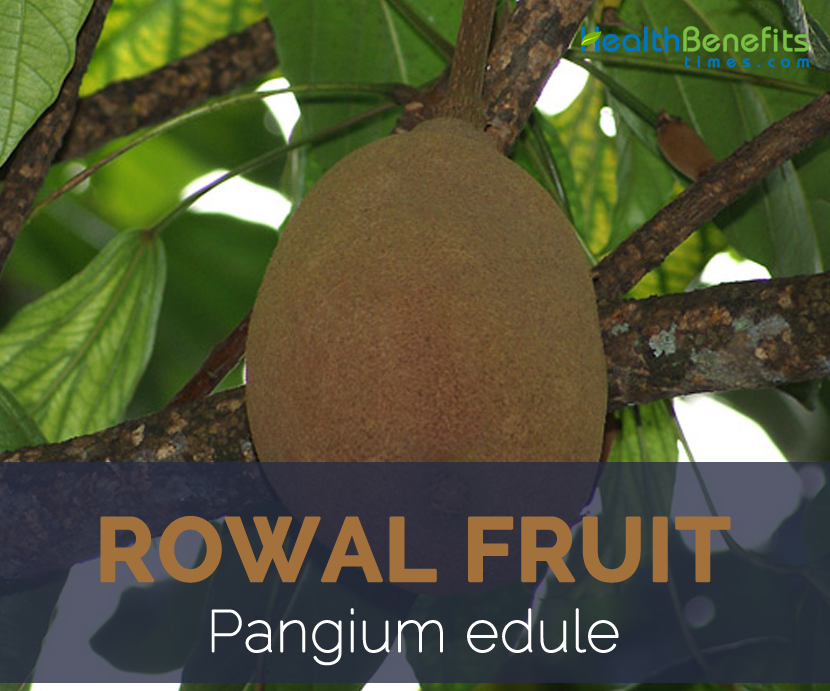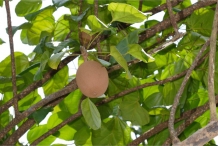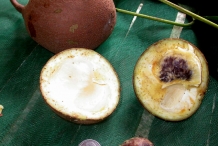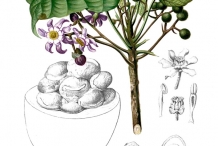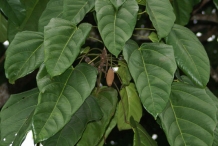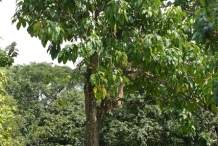| Rowal fruit Quick Facts |
| Name: |
Rowal fruit |
| Scientific Name: |
Pangium edule |
| Origin |
Occurs throughout Malesia, Melanesia and Micronesia |
| Colors |
Brown |
| Shapes |
Large, sub globose to ovoid-sub pyriform (football shaped), indehiscent, rough, brown, generally 15–30 cm long, and about half as thick |
| Flesh colors |
Pale yellow to bright yellow flesh. |
| Taste |
Similar to Durian |
| Calories |
253 Kcal./cup |
| Major nutrients |
Copper (268.56%)
Vitamin C (65.33%)
Iron (62.75%)
Carbohydrate (41.92%)
Total dietary Fiber (37.11%)
|
| Health benefits |
Alleviates PMS Syndrome, Weakness, Prevents cardiovascular diseases, Normalizes bowel movements, Immune System, Lowers Risk of Gout, Proper Growth |
| More facts about Rowal fruit |
Pangium edule also known as Rowal fruit is a tall tree in the Flacourtiaceae family and is native to Malesia, Melanesia and Micronesia. Apart from Rowal fruit it is also known as pangi, pakem, sis, riamel, kepayang football fruit and Sis Nut. In Indonesia, it is used to make a number of distinctive dishes. Apart from that it is also called Pucung in Indonesia, Rumrum in Papua New Guinea, Rawahn Falaka in Solomon Islands and Peyang in Malaysia.
Plant
Rowal fruit is actually a medium to large; much branched, evergreen perennial tree sized 18–40 m tall. The tree prefers little shade and is normally found growing in a slightly acidic soil. It is also found along riverbanks and inundated areas and on stony and clayey soils. It grows rapidly in the initial years. Trunk is up to 1 m of diameter with grey brown bark. Leaves are entire, broadly ovate, cordate to truncate base, 15–25 cm long, 3-lobed on young trees, acuminate, glossy green, nerves palmate. Flowers are mostly unisexual; male flowers occur in racemes, to 5 cm wide; with 2–3 calyx-lobes; 5 or 6 petals with a basal scale and many stamens. Female flowers are solitary, similar to male flowers, but have no stamens but with 5–6 staminodes alternating with the petals, ovary long-ovoid, thick-walled, 1-celled with 2–4 placentae and many ovules and sessile stigma.
Fruit
Fruits are the size and shape of footballs. Fruits are normally large, sub globose to ovoid-sub pyriform (football shaped), indehiscent, rough, brown, generally 15–30 cm long, and about half as thick. The exterior color of the fruits is brown. The outside skin is rough to the touch. The inner skin (rind) is pale yellow to white, around an inch thick. The skin is able to absorb falls from thirty feet without damage to the flesh inside. The inside is composed of large seeds surrounded by pale yellow to bright yellow flesh. The flattened grayish-brown seeds are about two inches long. The flesh has a strong aroma. Some people compare the taste and smell to durian. The fruit is normally eaten when the skin is soft to the touch.
History
Pangium edule also known as rowal fruit occurs throughout Malesia, Melanesia and Micronesia. They are mostly grown wild and cultivated in Malaysia, Indonesia, Papua New Guinea and Vanuatu. But nowadays it is found growing in almost all parts of the world with suitable environment.
Nutritional Value
Apart from their wonderful taste, rowal fruit is a good source of nutrients, vitamins and minerals. Consuming 228 gram of rowal fruit offers 2.417 mg of Copper, 58.8 mg of Vitamin C, 5.02 mg of Iron, 54.49 g of Carbohydrate, 14.1 g of Total dietary Fiber, 73 mg of Magnesium, 119 mg of Phosphorus, 0.353 mg of Manganese and 4.56 g of Total Fat.
Health benefits of Rowal Fruit
Rowal fruit is one of the nutritious and healthy fruit. There are several advantages of consuming Rowal fruit. The health benefits of Rowal fruit have been proven in various research studies, folklore remedies and Ayurvedic medicine. Many parts of rowal fruit are used for their medicinal benefits. Listed below are some of the popular health benefits of rowal fruit:
1. Proper Growth
Rowal fruit consists of considerable amount copper which is essential for normal growth and health. Thus, it is very important to include this mineral in balanced levels in your regular diets. Apart from that it is also helpful in the protection of the skeletal, nervous and cardiovascular systems. If you suffer from a copper deficiency, the normal and healthy growth of organs and tissues, as well as their proper oxygenation from an ample red blood cell concentration, would be impossible. So including copper rich foods like Rowal fruit in your regular diet will help to gain required amount of copper.
2. Lowers Risk of Gout
Vitamin C found in Rowal fruit is related with lowering the risk of gout. Gout is actually a painful, arthritis type condition mostly bothering the big toe. Big toe becomes stiff, swollen and painful as a result of excess uric acid leading to crystals formed in joints. Regular consumption of Rowal fruit is quite helpful for overcoming the gout problem as it consists of 58.8 mg of Vitamin C which is 65.33% of the daily recommended value.
3. Immune System
Rowal fruit consist of 5.02 mg of iron which is actually 62.75% of the daily recommended value. As we all know that Iron plays a key role in providing strength to the immune system of the human body. Thus, the body is made proficient enough to fight against a number of diseases and infections. Red blood cells are essential for providing oxygen to damaged tissues, organs, and cells. Without it, there would be no hemoglobin; without hemoglobin, there would be no oxygen. The healing process needs iron to happen!
4. Normalizes bowel movements
Dietary fiber found considerably in Rowal fruit help to increase the weight and size of stool as well as softens it. A bulky stool is easier to pass, reducing your chance of constipation. If you have loose, watery stools, fiber may help to solidify the stool because it absorbs water and adds bulk to stool. So including fiber rich foods like rowal fruit will be beneficial for normalizing bowel movements.
5. Prevents cardiovascular diseases
Magnesium found in Rowal fruit is associated with lowering the risk of coronary heart diseases. Dietary research has recommended that adequate magnesium intake help to reduce the chance of having a stroke. Magnesium deficiency increases the risk of abnormal heart rhythms, which increases the risk of complications after a heart attack. Thus, consuming recommended amounts of magnesium dietary supplements may be beneficial to the cardiovascular system.
6. Weakness
Regular consumption of Rowal fruit has the ability to remove minor health problems like muscle weakness, numbness, fatigue and similar ailments due to the presence of phosphorus. Normal levels of phosphorous within the body are a wonderful way to remain fit and active. According to experts and from suggestions of various health practitioners a normal amount can be approximately 1200 mg for adults. Apart from that sexual weakness can also be cured with healthy supplementation of phosphorous into the body, so issues like loss of libido, frigidity, impotence, and sperm motility can be boosted by having an adequate supply of phosphorus in your system.
7. Alleviates PMS Syndrome
Many women can suffer from premenstrual syndrome (PMS). Manganese contained in Rowal fruit helps to manage mood swings and reduce headaches, depression, and irritability. Women who suffer from severe PMS symptoms are recommended to consume manganese supplements as well as foods that are rich in manganese like Rowal fruit.
How to Eat
- Seed kernel is consumed in most provinces after extensive processing to remove a toxic substance, a cyanogenic glycoside within Papua New Guinea.
- Seed kernels are consumed after processing the seed by washing, fermentation and roasting or cooking in Papua New Guinea and Fiji.
- Seed kernel is only eaten after being washed in water, and then roasted and fermented seeds cooked with sago in bamboo tubes over fire in Papau.
- Seeds are boiled for several hours and the hard seed coat removed and the kernels soaked in several changes of water overnight.
- Soaked Kernels are Fried with meat or fish makes a savory dish.
- Keluak seed kernels are used in the Nyonya specialty cuisine such as Ayam buah keluak or babi buah keluak in Malaysia and Singapore.
- In Sabah, it is used in Bosou a signature dish for Kadazan Dusun which includes ingredients like raw freshwater fish, pangi, salt, steamed rice and some other optional ingredients such as jackfruits, young pineapple fruits, tahu (bean curd), etc.
- Seed kernels are used as an important basic ingredient for bumbu rawon – a mixture of spices: kemiri (candlenut), asam jawa (tamarind), kluwak (sisnut), bawang putih (garlic), kunyit (turmeric), lenguas (galangal), jahe (ginger) and lada (chilli) in Indonesia.
- Soto Rawon is a much enjoyed Indonesian soup with beef.
- This dark beef soup is served with mung bean sprouts and sambal.
- Young leaves also are edible after cooking and are cut into small pieces and used in the preparation of preserved meat ‘kasam’ in Sarawak.
- Edible oil obtained from the seeds is used for cooking in places where coconut was unavailable.
Other Traditional uses and benefits of Rowal fruit
- Seeds are stated to possess anthelmintic and narcotic properties in traditional medicine.
- All parts of the tree are considered to be anthelmintic in Philippines.
- Fresh crushed seeds have been used for boils and the leaves being anthelmintic were mixed with lime juice and salt and use for itch due to parasite, ulceration, wounds, and scurf in Malaysia.
- Penan consumes a decoction of the bark for constipation in Sarawak.
- A solution made from the seeds is used as shampoo and to remove head lice while oil extracted from the seeds is used as hair cream to produce healthy and shiny hair.
- Iban apply sap from the inner bark as antiseptic to treat wounds.
- Young leaves are scrubbed on the skin to treat infections.
- Fruit is sliced and the fruit juice is applied for sores and cuts in Papua New Guinea.
- Crushed bark from a mature tree is cooked in a soup and then given to lactating mothers. Their breast milk is then supposed to help the young child to become stronger and more resistant to illness.
- The inner bark is heated over a hot stone and the vapor produced is used as a steam bath to bring relief to swollen and painful joints.
Other Facts
- Seeds possess antiseptic property and are pounded and used for preservation of fish and shrimps in Java.
- Seeds are used to kill rats and wild chickens, and the pounded bark and leaves are used to stupefy fish so they can be scooped up easily.
- Kepayang oil has been used for making soap and to provide a red dye.
- Wood has been used for matchsticks.
Precautions
- All parts are credited with possessing narcotic attributes and an overdose will result in sleepiness, headache and intoxication leading to delirium and death in extreme cases.
References:
https://en.wikipedia.org/wiki/Pangium_edule
http://www.stuartxchange.com/Pangi.html
http://tropical.theferns.info/viewtropical.php?id=Pangium+edule
http://rfcarchives.org.au/Next/Fruits/Pangium/Pangium11-97.htm
http://www.hear.org/pier/species/pangium_edule.htm
https://npgsweb.ars-grin.gov/gringlobal/taxonomydetail.aspx?id=26427
Comments
comments


